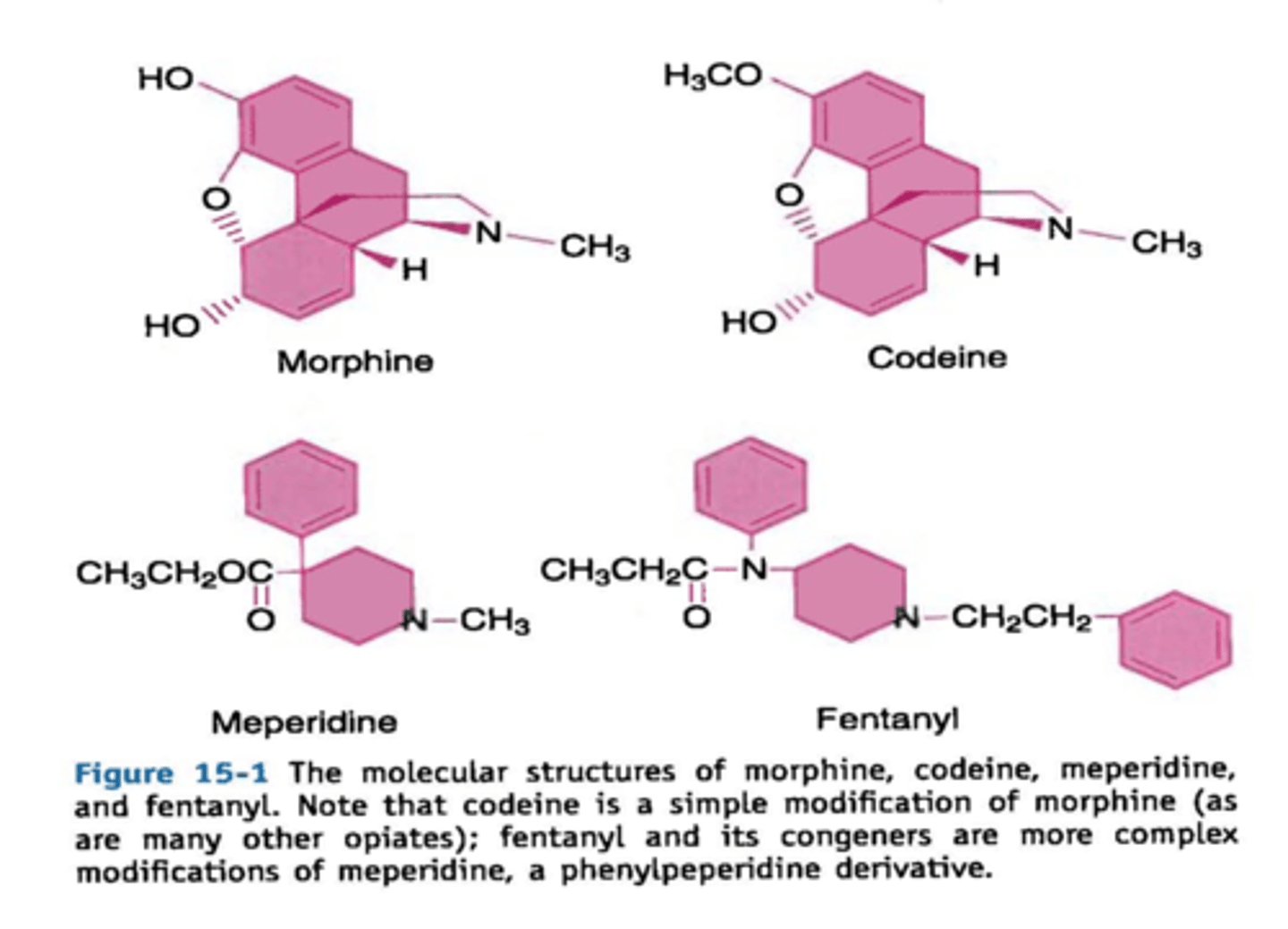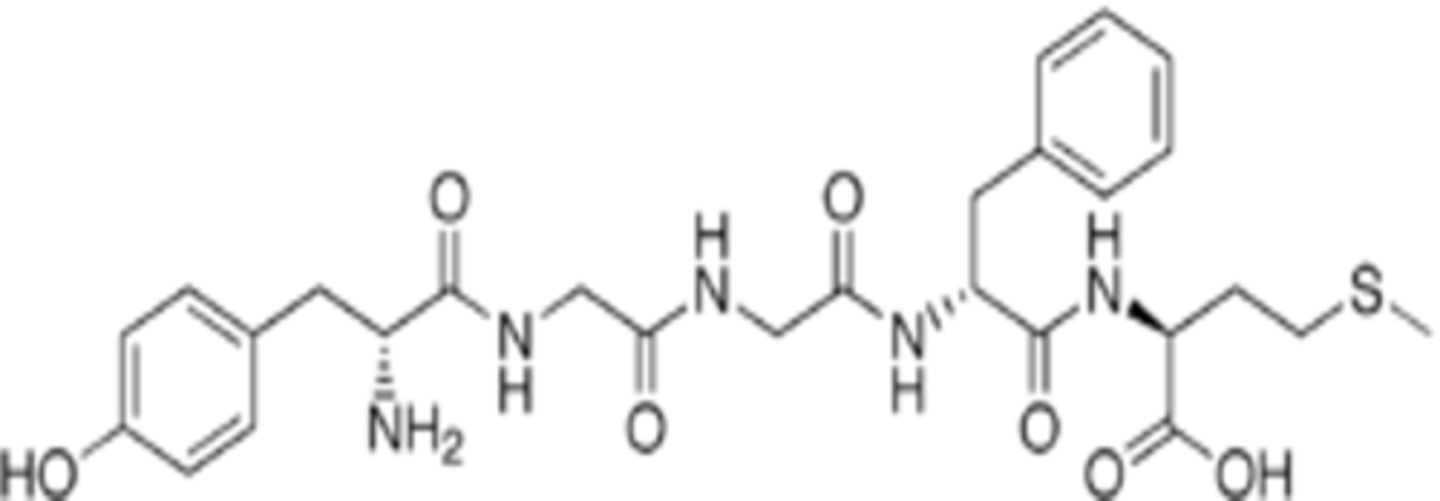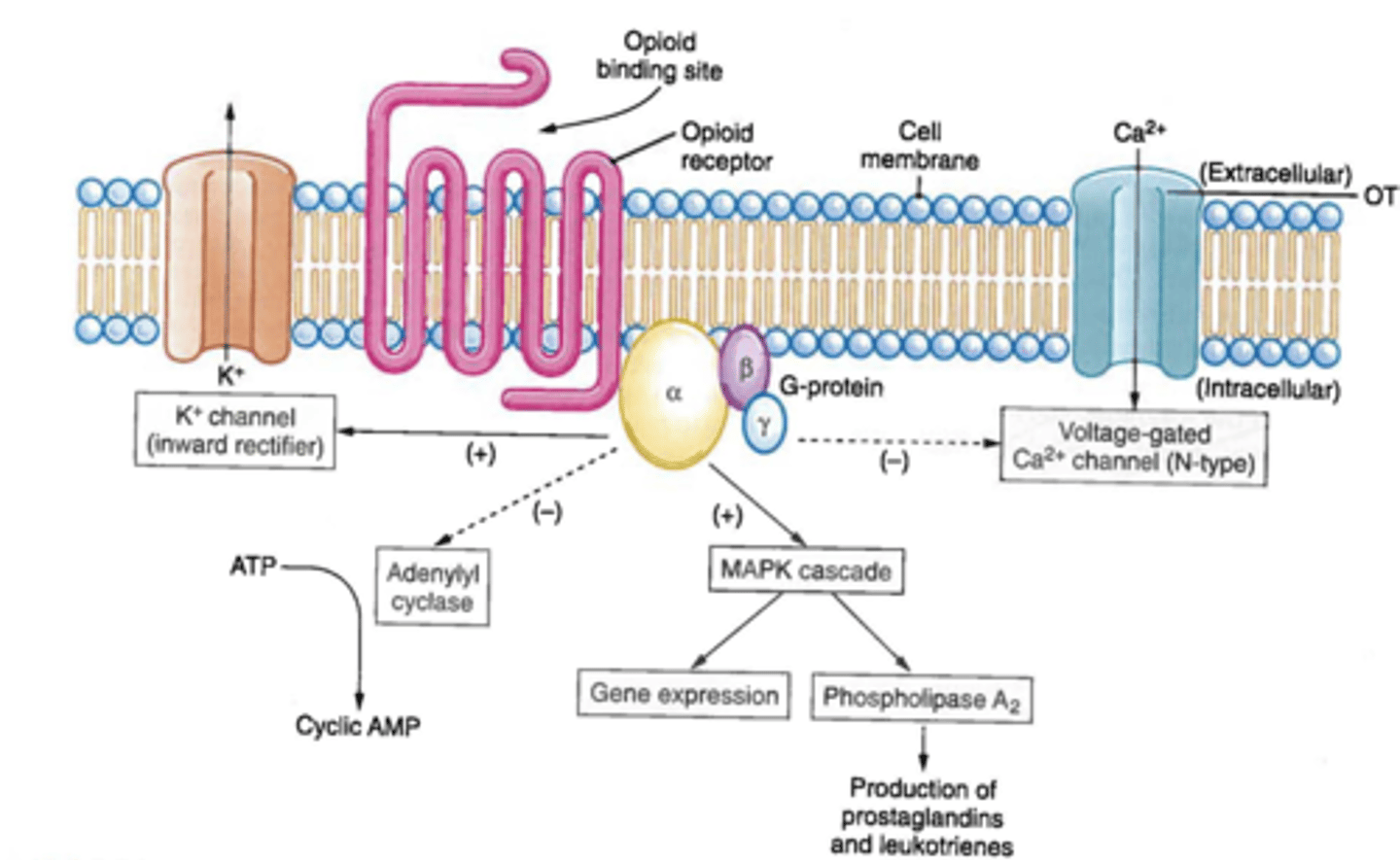Pharmacology II Exam 2: Opiods
1/259
There's no tags or description
Looks like no tags are added yet.
Name | Mastery | Learn | Test | Matching | Spaced |
|---|
No study sessions yet.
260 Terms
Brief hx of opioids:
All opioids are based off of?
Opium is the ?
Opiate is the ?
Opioid is the ?
*Opium
*brownish residue from the dried juice of poppy plant
*drug derived from opium - naturally occurring alkaloids: morphine, codeine, thebaine
*modern term for all substances (natural & synthetic) that bind to opioid receptors
how do opioid agonists work
blocks the ascending pathway via 1st and 2nd order neuron and engages the descending pathway via agonizing GABA (increasing cl)
what are the two main chemical classification groups of opioids and what is their structure?
1. benzylisoquinoline alkaloid - benzene ring not fused together
2. phenanthrenes-phenanthrene ring (3 fused benzene rings)
papaverine is the principle example of ____________________ that is a non-analgesic but an antispasmodic
benzylisoquinoline alkaloid
Morphine is a naturally occuring ___________ and is the principle active compound from opium used for pain
phenanthrene
_______ is the comparative for all agents and altered to make additional components
Morphine
if you substitute an ether for an alcohol of the phenanthrene nucleus of morphine you get _______________
codeine

_________________ was the first synthetic opioid
meperidine aka demerol
___________ is the prototype phenylpeperidine
meperidine
if you take morphine and split it between the 12th and 13th carbon to get a benzene connected to a 5 ring structure you get ____________ class of opioids
phenylpiperidine
T/F: synthetic opoids only have 2 of the original 5 rings of the basic morphine molecule
true
which drugs are your natural opioid agonists
1. morphine
2. thebaine
3. codeine
which drugs are your semi-synthetic opioid agonists
1. hydromorphone
2. heroine
3. oxymorphone
4. oxycodone
what are your synthetic opioid agonists
1. methadone
2. fentanyl
3. remifentanil
4. alfentanil
5. meperidine
6. sufentanil
7. tramadol
what are your semi-synthetic partial agonist opoids
buprenorphine
what meds are your synthetic partial agonists opioids
butorphanol (stadol)
which meds are your synthetic agonist-antagonist opioids
nalbuphine (nubane)
which meds are your semi-synthetic opioid anatagonists
naloxone & naltrexone
which meds are your synthetic opoid antagonists
nalmefene
which semi-synthetics are "morphine derivatives" (i.e. synthesized by making small changes to morphine molecule)
heroine, oxymorphone, and hydromorphone
if something is a "synthetic" opioid that means it contains the _______________ of morphine
phenanthrene nucleus
(generally) opioids are largely _________________ at physiologic pH
ionized (pKa > 7.45)
opioids primarily work _________
centrally
(generally) opioids are highly lipid ______________, weak _____________, and ______________ protein bound
soluble; bases; highly
what are the 3 opioid receptor classes
1. mu
2. kappa
3. delta
what are your endogenous opioid agonists
1. enkephalins
2. endorphins
3. dynorphins
4. nociceptin
5. endomorphin 1
6. endomorphin 2
opioid receptors are what type of receptors
G-coupled protein receptors
________________ are individual peptides that have their own specific precursors and share a common amino acid terminal sequence with a small variation
opioid agonists (endogenous & exogenous)
what is the amino acid terminal sequence all opioid agonists share
try-gly-gly-phe-met or leu
met or leu will be at the C-terminus
what is the terminal amino acid sequence of all opioid agonists called
the opioid motif or the opioid message
the specific amino acid sequence of the opioid agonist is necessary for what?
the endogenous agonists action with the receptor
Enkephalin is similar to the structure of _______
add more info on slide 12?
Morphine

G protein coupled receptor includes ____membrane loops that are both intracellular and extracellular.
7
3 opioid receptor subtypes share ___-___% sequence homology (same structure), Yet
diversity is greatest in the _______ loops/external portions of the protein and are thought to be
important in the discriminating between ligands
55-58
extracellular
describe the steps/effects at the cellular level of when a opioid agonist binds with a receptor
1. binding of opioid agonist with receptor - either endogenous or exogenous
2. activation of the G-protein
(3 distinct subunits)
3. produces inhibitory effects: (alpha) inhibits adenyl cyclase --> cAMP --> relaxes smooth muscle. Causes decreased conductance of Ca++ channels & opened K+ channels and Results in decreased neuronal excitation and inhibition of neurotransmitter/neuropeptide release; (alpha, beta & gamma) --> decreased Ca influx --> decreased neuronal excitation; (beta and gamma) --> increased K efflux --> hyperpolarization
4. results in membrane hyperpolarization and reduction of neuron excitability

abrupt withdrawal of opioid agonist can cause rebound disinhibition of __________________
cAMP
abrupt withdrawal of opioid receptor agonist --> disinhibition of cAMP --> what s/sx
1. increased irritability
2. restlessness
3. tremors
4. chills
5. muscle cramps
6. sweating
7. mydriasis
8. abdominal pain
9. diarrhea
10. increased HR
where are the opioid receptor locations in the brain
1. periaquaductal gray
2. limbic system
3. area postrema
4. cerebral cortex
5. thalamus
where are the opioid receptor locations in the spine
substantia geletanosa of the dorsal horn
where are the opioid receptors located in the GI system
intestines
Opioid receptors are also located in the? (4)
1. Vasculature
2.Heart
3. Lung
4. Immune system
_______________ analgesia occurs through activation of the opioid receptors in the brain that cause inhibition of the nerves involved in pain pathways- the message is not propagated anymore.
supraspinal
In supraspinal analgesia, the brainstem modulates ______transmission via inhibitory pathways of the ______.
nociceptive
spinal cord
_______________ analgesia occurs via activation of the presynaptic opioid receptors in the spine decreasing release of the neurotransmitters of the nociception
spinal
supraspinal analgesia + spinal analgesia =
synergistic pain relief
brainstem modulates nociceptive transmission via ________________ pathways of the spinal cord
inhibitory
opioid receptors in the _______________ inhibits the release of substance P and blocks the transfer of pain upwards
spine
opioid receptors in the GI --> __________________; and in the GU --> ________________
constipation/post-op ileus; increased urinary sphincter tone --> urinary retention
mu will cause ____________________ analgesia and kappa will cause _______________ analagesia
supraspinal & spinal; supraspinal & spinal
mu receptors cause what CV effects? kappa causes what CV effects
mu = bradycardia
kappa = no CV effects
respiratory effects of mu? kappa?
mu = respiratory depression
kappa = possible depression if high dose
CNS effects of mu
1. euphoria
2. sedation
3. prolactin release
4. mild hypothermia
5. catalepsy
6. indifference to environmental stimulus
CNS effects of kappa
1. sedation
2. dysphoria
3. psychomimetic reactions (delirium, hallucinations)
effect of mu and kappa on the pupil
miosis
which opioid receptor if activated will inhibit peristalsis, and cause N/V?
mu
which opioid receptor when agonized causes urinary retention? which receptor causes diuresis d/t inhibition of the vasopressin release
mu; kappa
which opioid receptor if activated causes pruritus
mu
_________ opioid receptors have high risk of physical dependence, and _______ receptors have a low abuse potential
mu; kappa
What opioid receptor is involved with antishivering?
Kappa
The delta receptor has what effects?
Resp depression
Urinary retention
Pruritus
physical dependence
which endogenous opioid ligands agonize the mu receptor
1. B-endorphin
2. endomorphin
which naturally occurring opioid ligand agonizes the kappa receptor
dynorphin
Which naturally occurring opioid agonizes the Delta receptor
Leu- Enkephalin
Met-Enkephalin
what are the different routes of opioid administration?
1. oral
2. nasal
3. transdermal
4. IM/IV
5. intrathecal
6. epidural
7. suppository
opioids absorption is _____________ orally, due to extensive _________________. Often why PO dose is much higher.
modest; first pass
the more _________________ an opioid is the __________ the absorption through nasal mucosa, oral mucosa and skin.
lipophillic; increased
opioids are distributed throughout the body via the _________ compartment model
2 (Vessel rich group)
metabolism of opioids
liver via cyp450 - some have active metabolites
The exception is ________ that is metabolized in the blood by esterase
remifentanil
generally primary excretion of opioids = ______________ and secondary = _______________
kidney; biliary system & GI tract
differences in use of opioids r/t anesthesia practice
1. higher analgesic requirement
2. co-administration of potent anesthetics and sedative agents
3. require the ability to support respirations until emergence
small dose opioids will have a termination of DOA by ________________
redistribution into peripheral compartments
larger doses/multiple doses/continuous infusions of opioids DOA is more dependent on __________________
metabolism
________________ is a key factor in if the effect of an opioid is therapeutic or adverse
Clinical setting
**Sedation from the mu receptor may be part of the therapeutic intent (OR) versus being an adverse effect (ER).
Opiods also dependent on?
•Body weight
•Renal failure
•Hepatic failure
•Cardio-pulmonary bypass
•Acid-base changes
•Hemorrhagic shock
considerations with the pharmacokinetics of opioids (7)
1. Narrow therapeutic index
2. balance btwn optimizing pain control and sedation
3. respiratory depression
4. variability between patients- dose and DOA
5. patients perception of pain - hx of chronic pain, opioid use? etc.
6. severity and duration of pain
7. lifestyle - smoking? etoh? illicit drug use?
what are the therapeutic effects of mu agonists (3)
1. pain relief (spinal and supraspinal)
2. sedation
3. anti-tussive
mu agonists are good for txing ___________ pain sensations, but less effective for ___________ pain sensations
"second pain" (c-fibers); "first pain" (A-delta)
Opioids provide a _____Dependent effect on drowsiness/sleep
dose
T/F: opioids can be used as a sole anesthetic
false; they do not reliably produce unresponsiveness and are not an anesthetic
T/F: The antitussive effect of Mu agonists suppress the cough center of the medulla (decreases the stimulation) but does not take away the cough
True
there is a risk for _____________________ reaction of increase in _______________ with bolus dosing opioids
paradoxical; coughing
what are the adverse effects of opioid agonists (13)
1. euphoria --> abuse
2. N/V
3. miosis --> pupillary constriction
4. vasodilation
5. bradycardia
6. ventilatory depression
7. increased biliary pressure
8. muscle rigidity
9. pruritus
10. delayed gastric emptying
11. ileus/constipation
12. urinary retention
13. depressed cellular immunity
**make sure all details form slide 20 on individual system cards
opioid CNS effects
1. sedation and eupohoria (mu) *both dependent on agent and receptor*
2. dysphoria (kappa) receptors or opioids taken in the absence of pain
3. analgesia
4. minimal effect of neuromonitoring
5. potential for increased ICP --> respiratory induced hypercarbia
analgesic MOA of opioid within the CNS
1. inhibit ascending transmission of nociceptive stimuli from the dorsal horn of SC
2. activate pain control pathways from the midbrain via the rostral ventromedial medulla to the spinal cord dorsal horn
opioids are most effective for continuous ____________ dull pain. At high doses, opioids will relieve _____pain.
visceral
any
undesired CNS effects of opioids (4)
1. dependence
2. tolerance/cross tolerance
3. awareness
4. hyperalgesia
Dependence of the drug can be _____&______. They need the drug to function properally
Physical and Psychological
_______________ to opioids begins with a decrease in DOA followed by decrease in effect. Chronic tolerance may involve?
tolerance
desinsitization? Down regulation?
There are lots of theories r/t tolerance that includes?
•Not due to altered receptor number
•Receptor internalization
•Activation of NMDA receptors
•2nd messenger changes
•G-protein uncoupling (changes in the binding sites)
Awareness: Mu agonists are ______anesthetics and do not reliably produce unresponsiveness or amnesia
NOT
Hyperalgesia can include?
*Increased Sensitivity to pain
*Damage to nociceptors or peripheral nerves
(Ex. degloving)
**Remifentanil can cause this
what is the most significant adverse effect of opioids
depression of ventilation
who is at increased risk of respiratory depression with use of opioids
1. High dose opioids
2. advanced Age
3. CNS depressants
4. renal insufficiency
5. Morphine sulfate
6. sleep: natural sleep depresses the response to co2 and potentiates resp depression caused by opioids
T/F: respiratory depression 2/2 opioid use is not an issue intraoperatively when the airway is secured and ventilation is controlled
true. Life threatening in post op period. Morbidly obese or OSA PTS are at increased risk of M and M
opioids will depress the response to ____________ and ____________ which results in a _____________ shift of the co2 responsive curve depressing the hypoxic drive to breathe
increased CO2; decreased O2; right
T/F: tolerance to opioids will decrease the miosis pupillary response
false; tolerance does not effect miosis with use
what is though to cause miosis with opioid use
1. opiate depression of GABA -->
2. stimulation of edinger-westphal nucleus -->
3. PNS signals via ciliary ganglion
4. stimulation of the oculomotor nerve to constrict
T/F: miosis with opioid use is reversible with narcan
true
Is miosis a qualitative or quantitative sign?
Qualitative